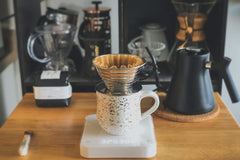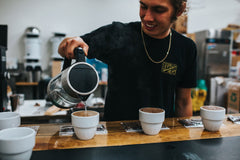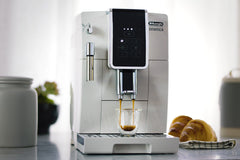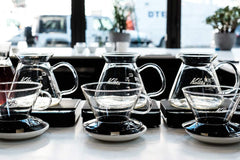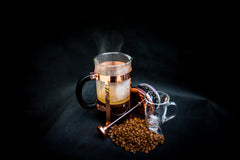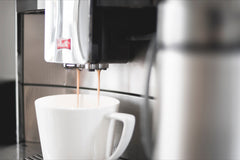
Taking the Heat Off for the Perfect Chilled Brew
There are times when you crave the smooth taste of a great quality coffee, except you aren’t in the mood for the typical steamy cup of brew.
These moments are the perfect time to explore the refreshing and smooth flavors of a cool, chilled brew instead.
There are two ways of properly preparing chilled coffee, cold brewed and iced.
When made with quality coffee, both will result in an enjoyable brew, however, they are quite different in both technique and flavor.
Talking Differences: Iced Coffee vs. Cold Brew
The main difference between iced coffee and cold brew is how each is made. Iced coffee is brewed double strength then cooled, resulting in a refreshing, lighter body. Cold brew, on the other hand, is made without heat resulting in lower acidity and a smoother, naturally sweet taste.
The ways that people like their coffee are as vast as the number of people who drink it. It is impossible to credit the true innovator who discovered that coffee is as delicious cold as it is hot. Chances are it was someone who returned to their half-finished robust cup after a long day of work.
Sometime in the late 1950s, the idea of cooling your coffee on purpose began to catch on. Decades later, iced coffee became popular, and now cold brew is stepping forward as the latest trend in refreshing coffee drinks.
If you have been under the assumption that iced and cold brewed coffee was the same, you are not alone.
In fact, it is a common misconception.
Here is a rundown of the main differences:
- Temperature: Iced coffee is brewed with hot water and then cooled, often with the addition of ice to expedite the process. Cold brew coffee is crafted using cold or room temperature water, much in the same way that you would brew a jug of tea out in the sun.
- Timing: Iced coffee has a shorter brew time because of the hot water used in the process. How long it takes to cool depends upon whether it is chilled or ice is added immediately. Cold brew coffee takes longer, anywhere from twelve to forty-eight hours when brewed properly.
- Taste: Cold brew tends to be smoother and a more low-acid coffee as the process can mellow the flavor characteristics of the bean. Ice brew tends to hold on to more acidity, with a flavor that can be a bit bitter, depending on the bean that is used.
- Strength: Cold brew coffee is stronger and more concentrated, whereas iced coffee is the same strength as hot brew coffee, just served at a different temperature. Ice coffee can become weak, or watered down, as ice is added when served. Cold brew coffee has a higher caffeine concentration because there is no heat used in the process and it is more concentrated.

Putting It on Ice: The Art and Science of the Perfect Iced Coffee
When you are looking for a simple, cool alternative to a traditional hot cup of coffee, iced coffee is the easiest and most versatile option. Ice coffee is crafted the same as hot brewed coffee, except that it is served chilled, typically with plenty of ice added.
The simplicity of this drink is beautiful.
When comparing ice coffee to cold brewed coffee, the heat used in brewing is a major contributing factor to the final differences in flavor. The optimal temperature for an ice coffee to be brewed before it is cooled is in the 195°-205°F range.
This level of heat changes the chemical structure of coffee through the process of oxidation. Oxidation changes the pH level of brewed coffee, making it slightly more acidic. This is just enough to cause subtle, yet noticeable changes in flavor.
When coffee is enjoyed warm, the heat mellows some of the more acidic and fruity notes. When served over ice, those notes are more prominent and shine through in the final product. The key to ice coffee that has lightly acidic with fruity undertones, rather than being bitter, is all about timing. While cold brewed coffee is crafted to sit and “mature” before it is enjoyed, ice coffee is quite the opposite.
Because of the heat involved in the brewing, the longer you let ice coffee sit before you drink it, the more it will oxidize. The very same oxidation process that gives your ice coffee the perfect acidity can quickly overpower it and make it too bitter.
If you have ever ordered an iced coffee and received a drink that was bitter, the reason why is it simply sat too long. Ice coffee should be brewed to order and enjoyed soon thereafter.
How much coffee you use to brew an ice coffee is entirely a matter of personal preference. If you prefer a lighter, more refreshing drink, stick to the same amount of grounds that you would use to brew a hot coffee.
Keeping in mind that the ice used will dilute the drink, you may want to use slightly more grounds than normal to compensate. Ice coffee is also highly adaptable and works well with sweeteners, flavored syrups and milk.
The Perfect Iced Coffee, Step by Step
This process uses a pour-over method, with ice in the receptacle to expedite cooling. If you prefer, you can also crash cool your ice coffee by brewing as normal, pouring over ice and then adding more ice until the desired temperature is reached.
- Step 1: Assemble a pour-over brewing system. You can purchase a pour over system rather inexpensively, or you can make one at home by simply placing a heavyweight filter in a filter basket or funnel so that the coffee drips into a container as it brews. Large mouth mason jars work well for a homemade pour over system. You can also use a standard drip coffee maker machine, and add the water in manually.
- Step 2: Add a cup of ice to the receptacle. You can adjust this amount if you are making a larger pot.
- Step 3: Add the appropriate amount of coffee to the filter. For ice coffee, a standard ground is fine. Use the amount of ground coffee that you would use if you were making hot coffee. If preferred, you can add a little more to compensate for the dilution that will occur when adding ice.
- Step 4: Heat your water to 195°-205°F.
- Step 5: Slowly pour the water over the grounds. In the pour over process, you are taking over the role of a coffee machine. A coffee machine takes a little bit of time to brew a great cup of coffee. The pour-over technique goes just a tad slower but helps to develop the flavors of the coffee even more. Pouring the water in should take one to three minutes, depending on how much coffee you are making.
- Step 6: Let your freshly brewed coffee sit and cool for several minutes. Meanwhile, place ice and any sweeteners or additives in a tall glass.
- Step 7: Stir or swirl the coffee and pour directly into your prepared glass.
- Step 8: Enjoy!

Brewing Cold and Slow: Good Things Are Worth Waiting For
Despite the long brew time, cold brew coffee is incredibly easy to make and offers up a taste sensation that is entirely its own. The complexity and flavors of cold brew coffee can be vastly different from ice coffee, even when using the same bean and roast.
Where the heat adds a bit more acidity to ice coffee, the lack of heat contributes unique qualities to a cold brew, and these unique qualities are the reason that cold brew coffee is one of the hottest trends in the industry.
Cold brew coffee is brewed with water that is either cool or room temperature, with a maximum optimal temperature of 68°-72°F. Water that is warmer than this will increase the rate that oxidation occurs and result in a product that is more similar in terms of flavor to ice coffee.
If it is the smooth and subtly complex flavors of cold brew that you are after, make sure to keep your brew water at or below this range.
Coffee brewed at this temperature is decidedly more mellow than hot brewed coffee, sometimes to the point that certain flavor notes seem to disappear entirely. This isn’t a bad thing, because in its place there is a nutty, natural sweetness that occurs.
Cold brew coffee is typically crafted using a higher concentration of grounds than the standard brew. There are several reasons why this is the case. First, the lower water temperature equals lower extraction, so you add more coffee to compensate, especially if you plan on steeping a shorter amount of time. Secondly, the higher concentration of grounds adds to the rich depth and mellow flavors.
Finally, ice brew blends wonderfully with milk, which cuts some of the thickness. Keep in mind that because cold brew is generally more concentrated than the caffeine content will slightly higher as well.
Cold brew has a bit of a reputation for being the “fussier” of the two chilled brews. This is not true. You do not need the same fancy equipment as your local barista to craft a quality cold brew. In fact, all you need is your favorite coarse ground coffee, water, a container and a filter to strain the grounds with.
The simplest process involves steeping the coffee like tea and then straining to drink. Can it get any easier than that?
The other non-fussy component of cold brew is that you don’t need the freshest beans. The lack of heat used in the cold brew means that certain compounds in the coffee remain unextracted. These are the same compounds that can cause a coffee to taste stale when brewed with hot water.
The next time you are wondering if your grind has gone stale, take a chance and try a cold brew. You won’t be disappointed.
The Perfect Cold Brew: Step by Step
For this process, we use a French press but simply steeping the coffee in water works fine too, if you have a sturdy filter to strain it with. The Hario Mizudashi cold brew works well too.
- Step 1: Pick your favorite coarse ground coffee. Coarse ground coffee stands up better to the long steep process of cold coffee brewing than a standard ground. Avoid fine ground coffee with this technique.
- Step 2: Add the coffee to a French press. Use 1 1/2 to 2 times the amount of grounds you would typically use for the same amount of coffee with a standard brew. The exact strength is personal preference, but remember that as far as flavor is concerned, the cold brew method will mellow it quite a bit.
- Step 3: Add water that is no warmer than 68°-72°F. You can use water that is cooler than this if desired.
- Step 4: Cover and let steep. The longer it steeps the more flavor will develop and the final product will be fuller bodied. Two hours is a very light cold brew, twelve hours is standard, twenty-four or more is rich and complex.
- Step 5: Strain the coffee, twice if necessary.
- Step 6: Add ice and additions to your glass and pour.
- Step 7: Enjoy!
Picking Your Favorite - Iced or Cold Brew Coffee
This, my friend, is all a matter of personal taste.
We at Nomad Coffee are committed to removing the pretentiousness from a great cup of coffee. Both styles of chilled coffee have great qualities, and each offers something uniquely different to the coffee experience.
Our suggestion is to not only try them both but to craft each of them in your own home using your personal choice of the best coffees around.
There is nothing difficult about a good cup of coffee, hot or cold. It is simply a matter of knowing what you like and having the best coffee to start with.
Ice coffee and cold brew can both be made easily and you get the benefit of adapting them to suit your own taste. We feel that the act of brewing coffee is part of the experience of enjoying it, we want you to enjoy your experience fully.

